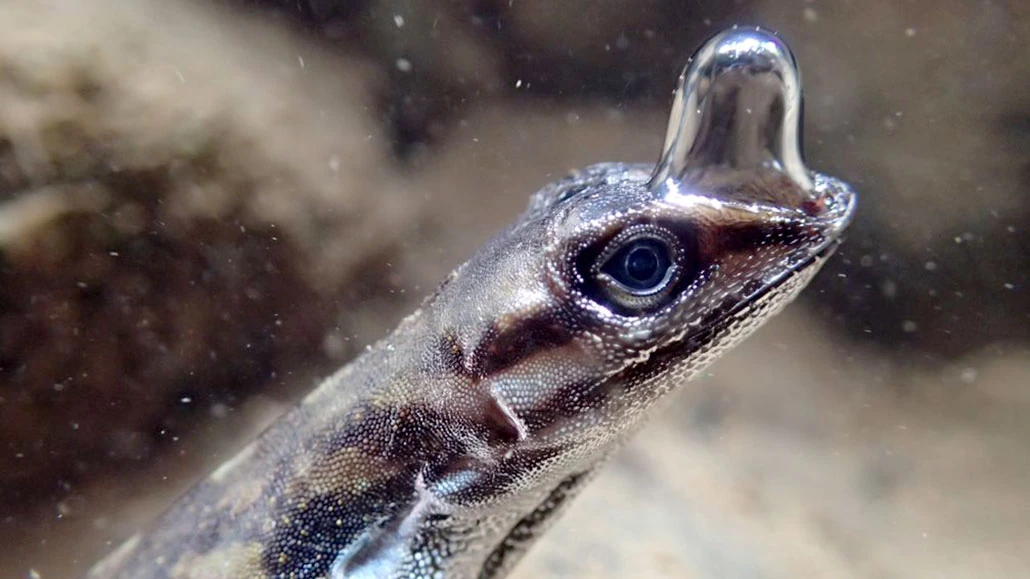Some lizards bought “scuba tanks” to survive
- September 18, 2024
- 0
A few years ago, scientists noticed a strange feature of anole lizards. The animals dived into streams and rivers and a rather noticeable air bubble appeared on their
A few years ago, scientists noticed a strange feature of anole lizards. The animals dived into streams and rivers and a rather noticeable air bubble appeared on their

A few years ago, scientists noticed a strange feature of anole lizards. The animals dived into streams and rivers and a rather noticeable air bubble appeared on their noses. At the same time, researchers assumed that this bubble helps anoles breathe underwater and for quite a long time, almost 20 minutes. However, it was not clear whether this mechanism is a biological adaptation for survival in the wild or a strange side effect of the hydrophobicity of the skin. Researchers from the USA put an end to this issue by conducting an experiment.
Water anoles (Anolis aquaticus) are small lizards, six to seven centimeters long, that live in the tropical forests of Costa Rica and Panama. Usually these animals live near rivers and streams, spending a lot of time in the water in search of food.
During field research in Costa Rica in 2015, ecologist Lindsey Sverk (Lindsey SwierkA research team from Binghamton University in New York observed that some anoles dive into streams and stay there for long periods of time when people or large animals approach. With the help of underwater video cameras, the scientists discovered that while in the water, the lizards blow out large air bubbles that remain attached to their noses through their nostrils. These pellets would sometimes disappear, then reappear.
In 2018, Sverk published a short paper describing this behavior. And three years later, the ecologist and his colleagues reported that there were at least 18 species of lizards in the genus. Anolis Use bubbles underwater to breathe air for at least 18 minutes (possibly much longer).
All 18 species have hydrophobic (water repellent) skin. When anoles go underwater, a thin layer of air remains on the skin, which is captured by the nostrils. During exhalation, the layer stretches, forming an air bubble. The bubbles can stick to the body because of the thin layer of air in the skin.
Sverk and his colleagues were not sure why air bubbles appeared: is it a side effect of the skin’s hydrophobicity or a biological adaptation? The scientist conducted an experiment and solved the problem. He presented his findings in a journal Biology Letters.
The researcher collected 28 water anoles in a tropical forest in southern Costa Rica and divided them into two groups. Tsvirkun applied body lotion (Honest Company daily moisturizer) to the first group to prevent air bubbles from sticking to their skin. Representatives of the second group were moistened with water to maintain the hydrophobicity of the skin and not to prevent the appearance of “scubalangs.”
Cricket then placed the lizards in a clear plastic tank filled with running water to see how long they could hold out before being released. The lizards in the second group, which had no product applied to their skin, blew larger air bubbles than the lizards in the first group and stayed underwater for 32 percent longer than the anoles who were coated in the cream.
The study concluded that the air bubble helps anoles stay underwater for much longer than they would normally. In other words, such a mechanism is a biological adaptation that allows you to escape from hungry predators.
Aquatic anoles are the first vertebrate species to acquire “scuba tanks” for breathing underwater. However, we note that such a feature is found not only in lizards, but also in small aquatic insects: for example, a similar mechanism is found in “alkaline flies” Ephidra hiansand some spiders as well.
In the silver spider (Argyroneta aquatica) an air bubble appears around the abdomen, held in place by water-repellent hairs, allowing it to live almost entirely underwater and only surface once every 24 hours. A spider’s bubble acts like a gill: it naturally takes in oxygen and releases carbon dioxide. In future research, Dr. Sverk will try to find out if aquatic anoles can do the same.
Source: Port Altele
As an experienced journalist and author, Mary has been reporting on the latest news and trends for over 5 years. With a passion for uncovering the stories behind the headlines, Mary has earned a reputation as a trusted voice in the world of journalism. Her writing style is insightful, engaging and thought-provoking, as she takes a deep dive into the most pressing issues of our time.